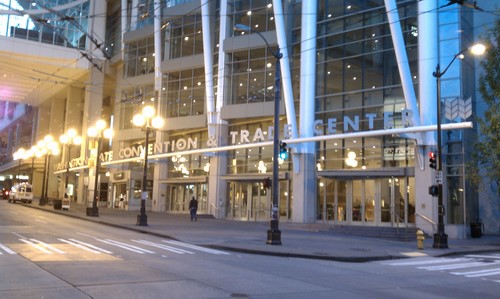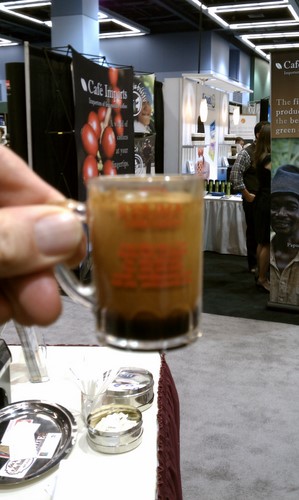(Note: If you missed Part 1, it's here)
In addition to the exhibitions, Coffee Fest also offered several free classes (and some paid ones) to help people improve their businesses and increase their coffee knowledge. Because I am one of those people who likes school, and because they were free, I decided to attend the Saturday morning classes. I had to get up at 6:15 to get there on time Fortunately, it was a beautiful clear, crisp morning and the walk to the bus stop was invigorating. The bus from Everett dropped me off a block from the convention center about twenty minutes before my first class started (Side note: Seattle’s public transportation, although primarily buses, is better than its reputation).
 The street lights were still on when I got to the convention center
The street lights were still on when I got to the convention center
My first class, “How to Effectively Compete with National brands,” was taught by Sol Salzer, one of the owners of the City Bean Coffee in Los Angeles. The first thing he did was to thank Starbucks and the other national chains (Peet’s, Gloria Jean’s, Coffee Bean, etc.) for raising the standards of the coffee industry. Then he spent the next hour talking about how to beat them. He used Starbucks as his main example, telling the story of how he used the Starbucks that moved in across the street to help grow his business. Starbucks brought many customers to the neighborhood, and City Bean was able to capture some of that traffic by effectively targeting them.
Salzer made it clear that if you try to copy what the national coffee chains are doing, you will get crushed. The average budget to build a new Starbucks store is $350,000—a new Peet’s, $450,000. Few independent café owners/entrepreneurs are able to put that kind of money into creating building a café. In addition, he said, if you take $1000 from each of the 100 Starbucks in the LA area, you can afford to buy a full-page ad in the LA Times. What independents have $100,000 available for that kind of marketing? Exactly—none! So they’d better excel in an area where the majors can’t or don’t.
Sol said that one of the best things independent owners can do for their businesses is to know their coffees very well. Be passionate about what you’re doing and this enthusiasm will transfer through to the customers, he said. Salzer and his business partner did coffee cuppings every day (“really, every day”) for three years in order to make sure they knew their product and could enthusiastically discuss it with the company’s employees and customers. That’s a lot of coffee, and it shows the dedication with which he has successfully taken on the biggest brands.
The second class of the day was put on by Lon LaFlamme (what a great name!) and was titled “Unleash the Outrageous Advantage of a Self-Directed Life”. Much like Sol Salzer did, Lon emphasized the need to be unique. In addition to that message, Lon spoke about having the courage to follow your own path. As you can imagine, this message resonated with me. I came away with renewed enthusiasm for this Caffeinated PDX project. Partly inspirational, partly technical and definitely entertaining, Lon’s talk was fun and inspiring for everyone who attended it. His best line of the session, as he was spoke about creating a unique path in life, was “Burn the damn box and invite everyone to the party!” Sounds good to me.
The third class of the morning was “Blending for an Italian Espresso” by Dr. Joseph John, the president of the Josuma Coffee Company. Dr. John has a Ph.D. in nuclear physics, and he spoke like a scientist about what makes an Italian espresso. He is what you might call an “espresso purist.”
A true Italian espresso, in his words, is “about an ounce of a dark, smooth, low-acid, heavy-bodied, aromatic, bitter-sweet coffee drink topped by a thick reddish-brown foam of tiny bubbles.” Of that definition, the most important parts are: the quantity (one ounce), the acidity (low) and the foam (or crema, which must be an emulsification that lasts over time). According to him, a good crema is the fundamental indicator of the quality of the espresso.
According to Dr. John, much of what is served in America today is really not espresso. “What we call Seattle, or Northwest espressos are really just brewed coffee,” he said. Roasters think that “they can take the same kind of coffees and just burn the hell of it and it will become an espresso.” Many of the roasters in Portland (or Seattle) would disagree with him—after all, ‘espresso’ refers to the speed at which the coffee is produced— but his point was that traditionally there is a definition of espresso who has some pretty narrow standards.
“From an Italian point of view, ‘single-origin espresso’ is an absolute farce,” he said. I was a little surprised to hear him say this, considering all of the single-origin espressos I have been drinking lately. He added that the Italians have created a definition of espresso italiano in reaction to what they see as a cheapening of their national treasure. True espressos include premium Robusta beans, which add body and persistence to the crema. This is somewhat sacrilegious in the US, where we have been told for the last twenty years that Robusta beans are all bad. Not all Robustas are the same, as not all Arabicas are the same.
Whether or not you agreed with Dr. John, he was very knowledgeable about espresso, and I learned quite a bit from his talk (Later in the day I stopped at his company’s booth and tried its espresso. It definitely had the characteristics that he spoke about in his talk—low acid, small quantity, and the most absurd amount of crema I have ever seen!)
 Look at that crema! (and forgive the focus)
Look at that crema! (and forgive the focus)
The fourth class I went to was put on by Connie Blumhardt, publisher of Portland-based Roast magazine. She spoke to café owners and other business owners about how to get free media coverage, particularly how to land articles in local and national publications. She also advised everyone to be careful when giving interviews, because sometimes things can be taken out of context or a reporter will focus on something that was really only a small part of the conversation. Her presentation was informative, and looking back, I probably should have stood up at the end of her talk and offered a free article on Caffeinated PDX to anyone who wanted it.
Overall, I was very pleased with the classes. I learned a lot and I assume that many of the people sitting next to me did too. The classes were interesting and professional and they made the early wake-up call worth it.